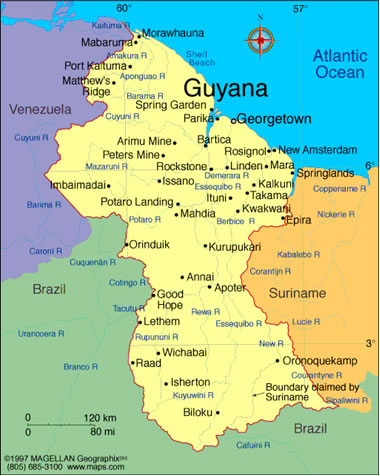- English
Department of Electoral Cooperation and Observation
 Guyana
General and Regional Election on May 11, 2015
Guyana
General and Regional Election on May 11, 2015

Country Profile
Population and Demographics
The most recent national census (September 2012) found a population of 747,884 persons. Estimates by the World Population Review put the 2014 population at 803,677¹, of which Indo-Guyanese, or East Indians, comprise the largest ethnic group at 44% of the population, and Afro-Guyanese, or African descendants, comprise the second-largest group at 30%. 17% of the population is of mixed heritage, and the indigenous Amerindians make up 9%. Guyana has a surface area of 83,000 square miles (214,969 sq. km). Ninety percent (90%) of its population is located in its narrow coastal belt – a strip 10 - 40 miles in width, and 285 miles long, comprising just 4% of the total land area.² Guyana’s capital, Georgetown, is home to about 240,000 persons. The remainder of the population lives in rural areas of the coastal belt and a small percentage in the hinterland.
Languages
Guyana is the only English speaking country in South America, in addition, Amerindian dialects; Creole, Caribbean Hindustani (a dialect of Hindi) and Urdu are commonly spoken throughout the country.
Economy
The Guyanese economy is based largely on agriculture and extractive industries, and is heavily dependent upon the export of six commodities - sugar, gold, bauxite, shrimp, timber, and rice - which represent nearly 60% of the country's GDP.

The most recent national census (September 2012) found a population of 747,884 persons. Estimates by the World Population Review put the 2014 population at 803,677¹, of which Indo-Guyanese, or East Indians, comprise the largest ethnic group at 44% of the population, and Afro-Guyanese, or African descendants, comprise the second-largest group at 30%. 17% of the population is of mixed heritage, and the indigenous Amerindians make up 9%. Guyana has a surface area of 83,000 square miles (214,969 sq. km). Ninety percent (90%) of its population is located in its narrow coastal belt – a strip 10 - 40 miles in width, and 285 miles long, comprising just 4% of the total land area.² Guyana’s capital, Georgetown, is home to about 240,000 persons. The remainder of the population lives in rural areas of the coastal belt and a small percentage in the hinterland.
Languages
Guyana is the only English speaking country in South America, in addition, Amerindian dialects; Creole, Caribbean Hindustani (a dialect of Hindi) and Urdu are commonly spoken throughout the country.
Economy
The Guyanese economy is based largely on agriculture and extractive industries, and is heavily dependent upon the export of six commodities - sugar, gold, bauxite, shrimp, timber, and rice - which represent nearly 60% of the country's GDP.






